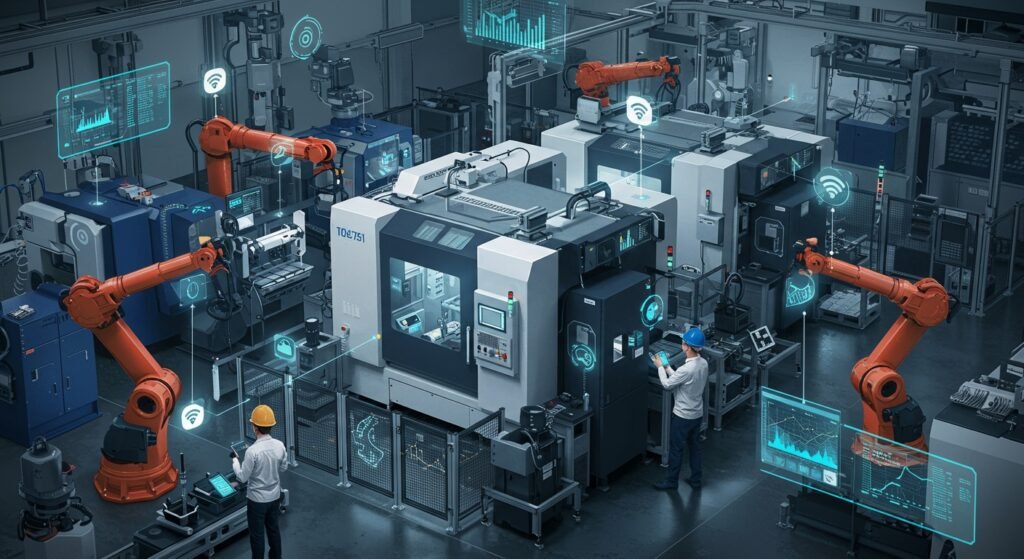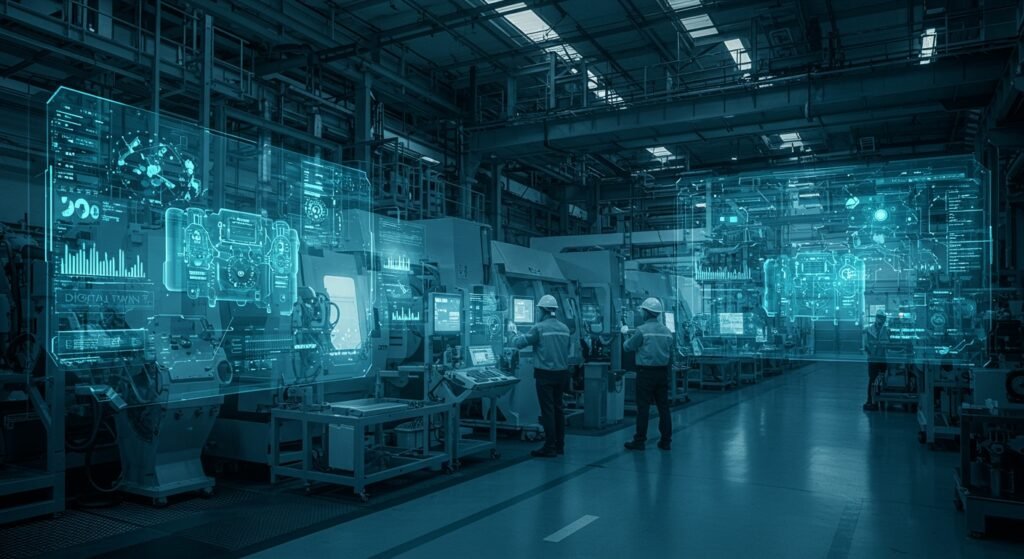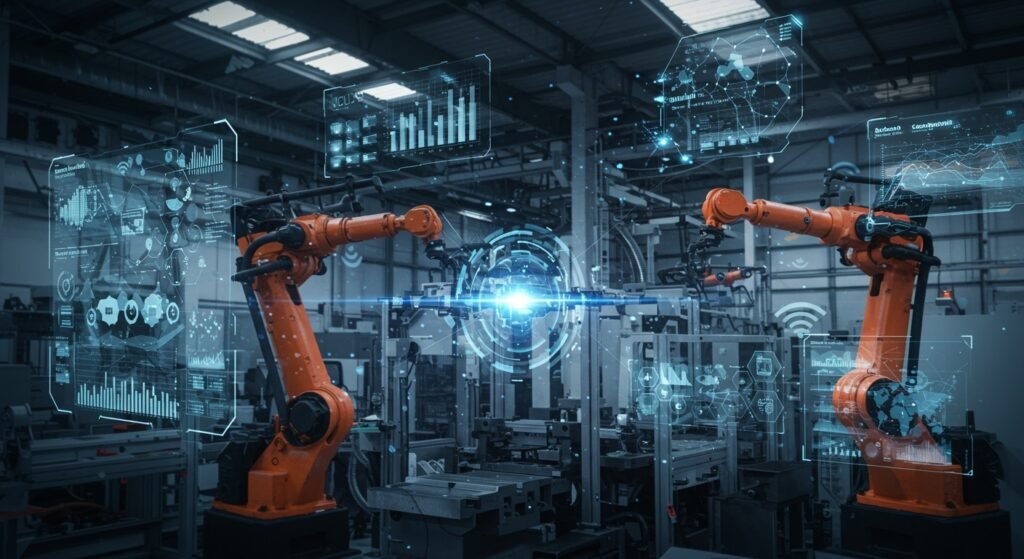<h1>Edge Computing & IIoT: Enhancing Decision-Making on the Factory Floor</h1><p>The Industrial Internet of Things (IIoT) is revolutionizing manufacturing, connecting devices, machines, and systems to create intelligent, data-rich environments. At the heart of this transformation are advanced <strong>IIoT applications</strong> that gather, process, and act upon vast quantities of operational data. While traditional cloud computing has been instrumental, the sheer volume and velocity of data generated on the factory floor demand a more immediate processing solution. This is where edge computing emerges as a game-changer, pushing computational power closer to the data source. By integrating edge computing with IIoT, businesses can significantly enhance decision-making, improve operational efficiency, and unlock new levels of productivity directly where the action happens.</p><h2>Table of Contents</h2><ul><li><a href="#introduction">Introduction: Edge Computing & IIoT</a></li><li><a href="#rise-of-edge">The Rise of Edge Computing in IIoT</a></li><li><a href="#benefits-iiot-apps">Key Benefits for IIoT Applications on the Factory Floor</a></li><li><a href="#practical-iiot-apps">Practical IIoT Applications in Manufacturing</a></li><li><a href="#challenges-solutions">Challenges and Solutions</a></li><li><a href="#conclusion">Conclusion</a></li></ul><h2 id="rise-of-edge">The Rise of Edge Computing in IIoT</h2><p>Edge computing represents a paradigm shift from centralized data processing to distributed intelligence. In an IIoT context, edge devices – sensors, gateways, controllers – are equipped with processing capabilities to analyze data right where it’s generated, whether it’s on a production line, within a machine, or at a remote facility. This decentralization dramatically reduces the need to send all raw data to the cloud for analysis, leading to quicker insights and more agile responses. The convergence of IIoT and edge computing is not just about technology; it’s about enabling a new era of responsiveness and efficiency in industrial operations.</p><h3>Bridging the Gap: Data Proximity</h3><p>Historically, all industrial data had to travel to a central server or cloud for analysis, introducing latency and consuming significant bandwidth. Edge computing minimizes this journey. By performing preliminary processing at the ‘edge,’ only aggregated or critical data needs to be transmitted further, making the entire data pipeline more efficient. This proximity of computation to the data source is crucial for time-sensitive operations like robotic control, real-time quality checks, and predictive maintenance algorithms that require instantaneous feedback.</p><h2 id="benefits-iiot-apps">Key Benefits for <strong>IIoT Applications</strong> on the Factory Floor</h2><p>The synergy between edge computing and IIoT unlocks a multitude of advantages that directly impact the bottom line and operational capabilities. These benefits are particularly pronounced in resource-intensive environments like manufacturing, where milliseconds can translate into significant gains or losses. Enhancing decision-making begins with faster, more reliable data.</p><h3>Real-time Data Processing</h3><p>Perhaps the most significant advantage is the ability to process data in real-time. Edge devices can instantly analyze sensor readings, machine diagnostics, and production metrics, allowing for immediate identification of anomalies or opportunities. For example, a machine showing signs of overheating can trigger an alert and even initiate corrective action automatically, preventing costly downtime before it occurs. This level of responsiveness is vital for critical industrial processes where delays are unacceptable.</p><h3>Enhanced Security and Compliance</h3><p>Processing data locally at the edge reduces the amount of sensitive information transmitted over networks and stored in centralized cloud environments. This localized processing limits exposure to cyber threats and simplifies compliance with data residency regulations, which are becoming increasingly stringent in various industries. By keeping critical operational data within the factory’s perimeter, organizations gain greater control over their intellectual property and operational secrets.</p><h3>Reduced Latency and Bandwidth Costs</h3><p>Sending massive streams of raw data from hundreds or thousands of IIoT devices to the cloud can overwhelm network infrastructure and incur substantial bandwidth costs. Edge computing tackles this by filtering, aggregating, and analyzing data locally. Only relevant insights or compressed data sets are then sent to the cloud for long-term storage or deeper analytics. This optimization not only reduces latency, which is critical for closed-loop control systems, but also significantly lowers operational expenses associated with data transmission.</p><h2 id="practical-iiot-apps">Practical <strong>IIoT Applications</strong> in Manufacturing</h2><p>The transformative power of edge computing is best illustrated through its impact on specific <strong>IIoT applications</strong> within manufacturing. From optimizing equipment performance to ensuring product quality, these applications redefine what’s possible on the factory floor.</p><h3>Predictive Maintenance</h3><p>Predictive maintenance stands as a prime example of an IIoT application greatly enhanced by edge computing. Instead of relying on scheduled maintenance (preventive) or waiting for failures (reactive), sensors on machines continuously monitor parameters like vibration, temperature, and current draw. Edge devices analyze this data in real-time to detect subtle deviations that signal impending equipment failure. This allows maintenance teams to intervene proactively, scheduling repairs at optimal times, minimizing downtime, and extending asset lifespan.</p><h3>Comparative Analysis: Traditional vs. Edge-Enhanced IIoT Data Processing</h3><table border="1"><thead><tr><th>Feature</th><th>Traditional Cloud-based IIoT</th><th>Edge-Enhanced IIoT</th></tr></thead><tbody><tr><td>Data Processing Location</td><td>Centralized cloud servers</td><td>Locally at device/gateway, then cloud</td></tr><tr><td>Latency for Action</td><td>High (round trip to cloud)</td><td>Very Low (local processing)</td></tr><tr><td>Bandwidth Requirement</td><td>High (raw data upload)</td><td>Low (only processed data/alerts upload)</td></tr><tr><td>Security Risk</td><td>Higher (more data in transit)</td><td>Lower (data processed locally)</td></tr><tr><td>Real-time Decision-Making</td><td>Challenged by latency</td><td>Highly effective</td></tr></tbody></table><h3>Quality Control and Anomaly Detection</h3><p>In fast-paced production environments, ensuring consistent product quality is paramount. Edge-based IIoT systems can employ cameras and sensors to inspect products in real-time, identifying defects or deviations from specifications as they occur. Machine learning models, trained in the cloud but deployed at the edge, can quickly recognize anomalies on the production line, triggering alerts or even halting processes to prevent further waste. This proactive quality control significantly reduces scrap rates and improves customer satisfaction.</p><h3>Asset Tracking and Optimization</h3><p>Beyond individual machines, <strong>IIoT applications</strong> powered by edge computing can track the movement and status of assets across the entire factory floor. From inventory levels to work-in-progress materials and tools, real-time location data and performance metrics are collected and analyzed locally. This enables optimized resource allocation, improved workflow efficiency, and better utilization of expensive equipment. For more insights on efficient asset management, you might consider exploring various approaches to <a href="/blog/optimizing-iot-integration">optimizing IoT integration</a>.</p><h2 id="challenges-solutions">Challenges and Solutions</h2><p>While the benefits are clear, implementing edge computing for IIoT is not without its hurdles. Organizations must strategically address integration complexities, data governance, and scalability to fully harness its potential.</p><h3>Integration Complexity</h3><p>Integrating new edge devices and platforms with existing legacy systems can be a significant challenge. Factories often operate with a mix of old and new machinery, each with different communication protocols and data formats. Solutions involve adopting standardized APIs, employing middleware, and leveraging industrial communication protocols like OPC UA or MQTT to ensure seamless data flow. For more technical details on industrial networking, a good resource is the <a href="https://www.i-scoop.eu/industrial-internet-of-things-iiot/" rel="nofollow">I-SCOOP Industrial IoT overview</a>.</p><h3>Data Governance</h3><p>With data being processed both at the edge and in the cloud, establishing clear data governance policies is critical. This includes defining data ownership, access controls, retention policies, and compliance measures across the distributed infrastructure. A robust data strategy ensures that the right data is available to the right people at the right time, while maintaining security and privacy.</p><h2 id="conclusion">Conclusion</h2><p>The convergence of edge computing and the Industrial Internet of Things is not merely an evolutionary step but a revolutionary leap for manufacturing. By empowering <strong>IIoT applications</strong> with localized intelligence, factories can achieve unprecedented levels of real-time insight, operational agility, and data security. The ability to make faster, more informed decisions directly on the factory floor is transforming industries, driving efficiency, and paving the way for truly smart manufacturing environments. Embracing this powerful combination is essential for businesses looking to stay competitive and innovative in the digital age.</p>
10 Revolutionary IIoT Applications: Boosting Factory Decision-Making with Edge Computing


